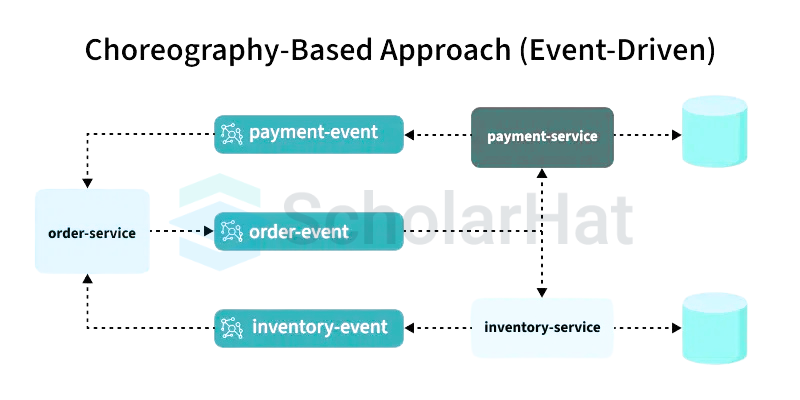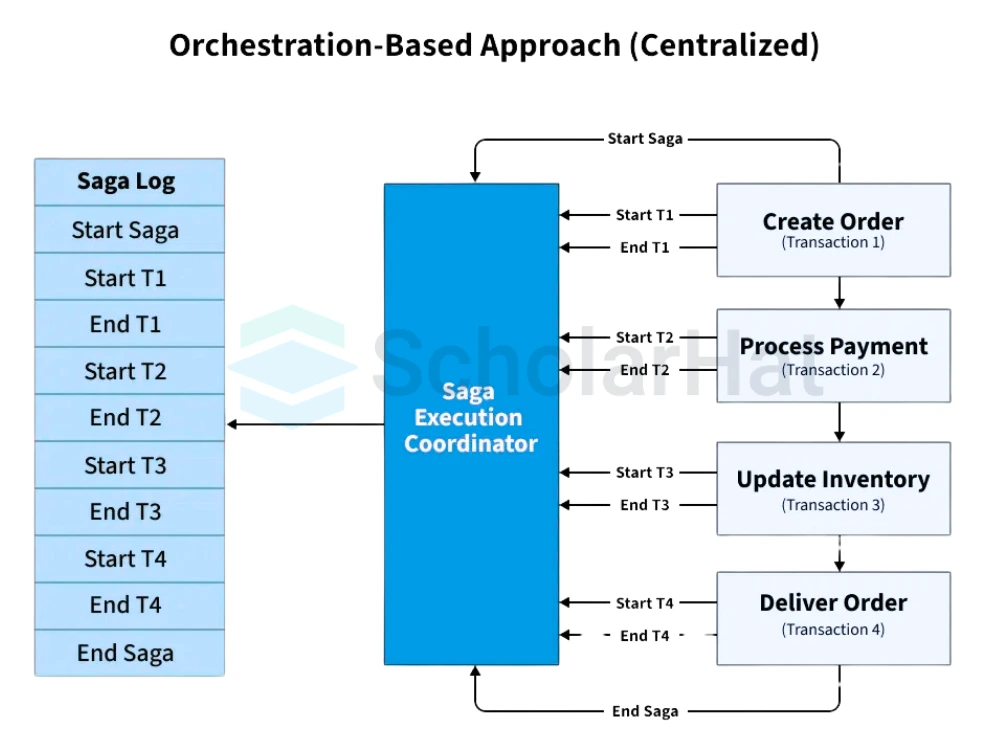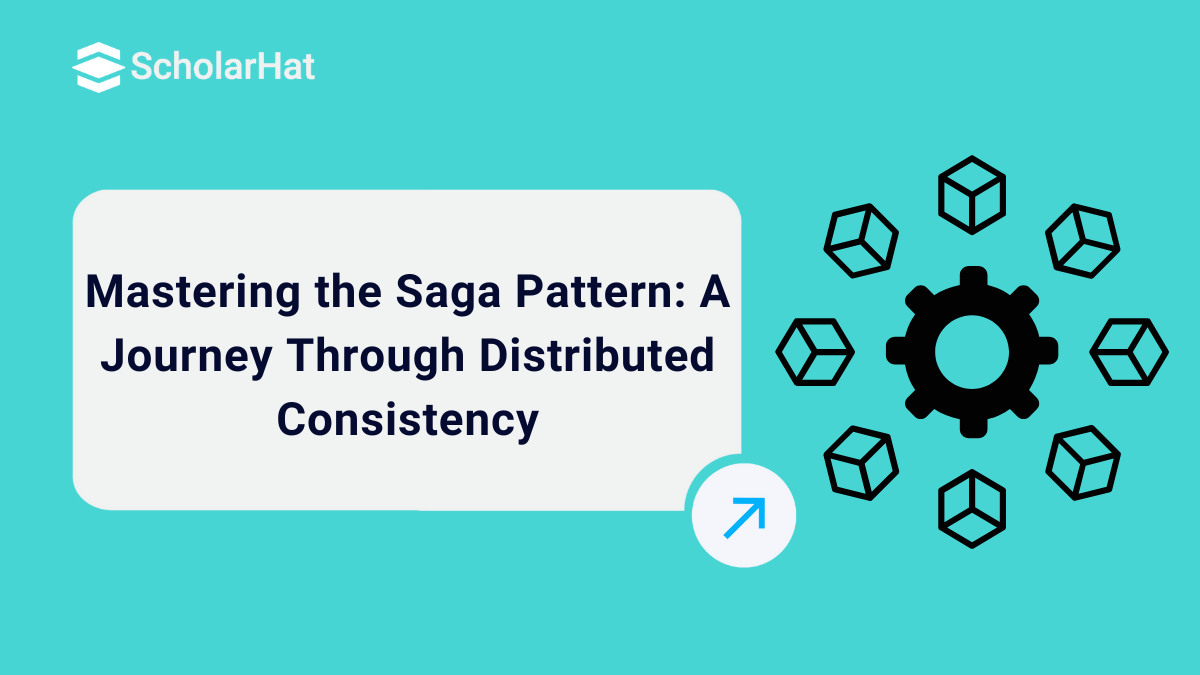26
DecSaga Design Pattern - A Complete Guide (2025)
Saga Design Pattern is a widely used architectural pattern for managing data consistency in distributed systems, especially when working with microservices. Instead of using a single long transaction, the saga pattern breaks it into a series of smaller, local transactions that are coordinated using events or commands. If one step fails, the pattern triggers compensating actions to undo the previous steps, ensuring the system remains consistent.
In this Design Pattern tutorial, you’ll learn how the Saga Design Pattern works, when to use it, and how to implement it in a microservices architecture. Whether you're building scalable enterprise systems or preparing for interviews, understanding sagas can greatly improve your system reliability. Master .NET Design Patterns to increase your earning potential by 20%. Enroll in our Free .NET Design Patterns Course with Certificate today!
The Ultimate Guide to the Saga Design Pattern
If you’re working with microservices, you might run into problems when a task needs to happen across multiple services. That’s where the Saga Design Pattern comes in. It helps you manage big tasks by breaking them into smaller steps that can run one at a time, in the right order. In this guide, you’re going to learn what the Saga Design Pattern is, how it works, and why it’s useful when you're building reliable systems. By the end, you’ll understand how to use it in your own projects to keep things running smoothly.
When you're building apps that talk to lots of different services, things can go wrong. One service might fail while the others keep going. The Saga Design Pattern helps handle those situations by making sure each step can either complete or undo itself if something breaks. So instead of everything crashing, your app can recover smoothly. You don’t have to rely on one big transaction; you let each service do its part and stay in sync with the rest.
What is the Saga Design Pattern?
The Saga Design Pattern helps you do big tasks that are split across many services, like in a microservices setup. Instead of doing everything at once, each service does its part, one after the other. If something goes wrong in the middle, the system can go back and fix or undo the earlier steps. You are using this pattern to keep things in order, so your app works well even if something breaks. It’s a smart way to keep the system safe and running when many parts are working together.

1. Explanation of Sagas in Simple Terms
2. Historical Context and Origin (CQRS & Event Sourcing)
The idea of Sagas came from the world of databases in the 1980s, but it became popular again with the rise of CQRS (Command Query Responsibility Segregation) and Event Sourcing. In CQRS, commands change data, and events track those changes. Since you can’t use regular database transactions across services, sagas became a way to manage business logic in a clean and reliable way, using events to move from one step to the next.
Why do we need the SAGA Design Pattern?
- Keeps data consistent across different services
- Helps your app recover smoothly from failures
- Allows services to work independently without waiting for a big transaction
- Makes error handling easier and clearer
- Improves the speed and scalability of your system
Core Concepts of the Saga Design Pattern
The Saga Design Pattern is a smart way to manage long-running distributed transactions, especially in microservices. Instead of handling a big transaction all at once, it breaks the work into smaller steps. Each step is done by a different service and has its own compensating action if something goes wrong. Here’s how it works:
- Breaking Down the Transaction: A large distributed transaction is split into smaller, independent steps. For example, booking a flight, reserving a hotel, and arranging a car rental all handled by different services.
- Independent Execution: Each step runs independently without waiting for others to finish. Once a step succeeds, the next one begins.
- Saga Coordinator: This component manages and coordinates the flow of all steps, ensuring they happen in the right order.
- Compensating Actions: If any step fails, the Saga Design Pattern runs compensating actions to undo the previous successful steps, like canceling a booking or refunding a payment.
- Saga Log: The saga log tracks the status of each step in the transaction, making sure every part completes or is properly rolled back in case of failure.
Types of Saga Design Pattern
There are two main types of the Saga Design Pattern: Choreographed Sagas and Orchestration Sagas. Both help you handle tasks that happen across many services in a distributed system, but they work in different ways.
- Choreographed Sagas: In this type, each service listens for events and decides when to act next. There is no central controller, so the services work independently by reacting to each other. This is best if you want loose coupling and less control in the system.
- Orchestration Sagas: Here, a central Saga orchestrator controls the process. It tells each service what to do and when. This type is helpful when you want clear control and easy monitoring of the whole workflow.
When to Use Each Type:
- Use Choreographed Sagas when your services are independent and you want to avoid one service controlling everything.
- Use Orchestration Sagas when you need to manage the steps closely and track progress clearly.
Choosing the right Saga type helps you build reliable and scalable microservices, keeping data consistent and processes smooth.
Saga in CQRS and Event Sourcing
In the CQRS (Command Query Responsibility Segregation) architecture, Sagas help coordinate processes that happen across different parts of the system. When you use CQRS, commands change data, and queries read data. Sagas make sure that when one service changes something, other services react correctly to keep everything in sync.
Sagas also work well with Event Sourcing, where every change is stored as an event. By integrating with Event Sourcing, Sagas track these events and use them to decide what to do next. This helps keep your system consistent and reliable, even when many services are involved.
Using the Saga Design Pattern in CQRS makes your system smarter at handling complex business processes without losing data or getting out of order.
Approaches to Implementing the Saga Design Pattern
Below are the two main approaches to implementing the SAGA pattern:
1. Choreography-Based Approach
- In the Saga Design Pattern, there is no central coordinator controlling everything.
- Each microservice knows what to do next and triggers the next step by sending an event.
- Microservices communicate through events using message queues or event streams.
- Each microservice listens for events and performs its task when an event happens.
- Microservices work independently and only need to know which events to react to, not the details of other services.
- If a microservice fails, it sends a failure event.
- Other microservices listen to failure events and perform compensating actions to keep the system consistent.

2. Orchestration-Based Approach
- One main service, called the Saga Orchestrator, controls the whole process.
- The orchestrator tells each service when to start and what to do next.
- It knows the details of each service and what job they have in the process.
- If something goes wrong, the orchestrator handles it and tells other services to undo their actions

Event-Driven Architecture and Sagas
In an event-driven architecture, systems communicate by sending and reacting to events. The Saga Design Pattern fits perfectly here because it uses events to manage complex processes that happen across many services.
Event Handling in Sagas:
Sagas listen for events that show when a service finishes its task. When an event arrives, the saga decides what to do next, either start the next step or run a compensating action if something goes wrong. This event-driven flow helps keep everything in order without needing a central controller.
Using Sagas in event-driven systems makes your applications more reliable and easier to manage, especially when multiple services work together.
Implementing Saga in Distributed Architectures
In microservices, many services need to talk and work together without breaking anything. Using Saga makes sure each step happens the right way, even if some parts fail.
1. Saga in Microservices
When you work with microservices, small services that do specific jobs, you can use the Saga Design Pattern to handle big tasks that need many services. Each microservice does its own step, and the Saga helps keep everything in order.
To implement Sagas in microservices, you break tasks into smaller parts and let each service finish its work. If something goes wrong, the Saga runs steps to undo earlier work and fix the problem. This way, your system stays reliable.
When designing Sagas, it’s important to think about scalability and fault tolerance. This means your system can grow easily and keep working even if some services fail. Using Sagas helps your microservices work smoothly together, making your app strong and ready for more users.
2. State Management in Sagas
When you use the Saga Design Pattern, it’s important to keep track of what each step is doing. This is called state management. You need to know which steps are done, which are running, and if any need to be fixed.
To manage state, you can use different ways to save this information safely. Often, the Saga’s state is stored in durable storage like databases or message queues. This helps your system remember the progress even if something stops or restarts.
Using good state management in Sagas makes your app more reliable and helps handle failures without losing track of the work.
Testing and Debugging Sagas
Testing Sagas in a distributed system can be a bit challenging because you're dealing with many moving parts. Each service does its own step, and you need to be sure everything works togethereven when something goes wrong.
1. Testing Strategies
Testing Sagas in a distributed system can be a bit challenging because you're dealing with many moving parts. Each service does its own step, and you need to be sure everything works togethereven when something goes wrong.
Common Challenges in Testing Sagas:
- It's hard to test every possible failure and how the system responds.
- Services may behave differently in testing than in real usage.
- Compensating actions are often forgotten or not tested properly.
Practical Testing Approaches and Tools:
- Unit test each step: Make sure each service can do its part correctly.
- Simulate failures: Use mock data or fake events to test how the system reacts.
- Use integration tests: Check if all services work well together.
- Try tools like Postman, WireMock, or test containers: These can help simulate service calls and events.
- Automate your tests: Run them often to catch issues early.
2. Debugging Techniques
When something breaks in a Saga, you need a clear way to find and fix the problem. Good logging and tracking help you know what happened and where things went wrong.
Tips for Debugging Sagas:
- Look at the logs: Logs show the full path of each step and help find the point of failure.
- Check error messages: They often tell you what went wrong or which service had trouble.
- Use tracing tools: Tools like Jaeger or Zipkin help follow a Saga across services.
- Check compensating steps: Make sure undo actions were called if something failed.
- Keep state info stored safely: This helps track what has already happened in case of restarts.
Good testing and debugging make your Sagas more reliable, helping you build stronger, safer microservices.
Performance and Scalability Considerations
When you use the Saga Design Pattern in a system with many services, it’s important to think about how fast it runs and how well it handles more users. Let’s look at how to improve performance and make your system scale smoothly.
1. Performance Optimization
Sagas run across multiple services, so small delays can add up. To keep things running smoothly, you need to focus on speed and efficiency.
Best practices for better performance:
- Keep steps short and simple: The faster each service finishes, the better the whole Saga runs.
- Avoid blocking calls: Use asynchronous communication to speed things up.
- Monitor performance: Use tools to check how long each step takes.
- Use lightweight messages: Smaller messages move faster between services.
Managing latency and throughput:
- Try to reduce the waiting time between steps.
- Process multiple Sagas in parallel where possible.
- Use fast data stores and cache common data to avoid delays.
2. Scalability Patterns
As your system grows, more Sagas will run at the same time. You need smart ways to handle the load without slowing things down.
Horizontal scaling strategies:
- Add more instances of your services to handle extra work.
- Use stateless services so they can be scaled easily.
Load balancing techniques for Sagas:
- Spread requests evenly across services using a load balancer
- Use message queues (like Kafka or RabbitMQ) to handle traffic smoothly.
- Make sure your saga coordinator (if used) can scale, too.
By thinking about performance and scalability early, you make sure your Saga-based system stays fast, reliable, and ready for growth.
Monitoring and Observability
When you're using the Saga Design Pattern in a system with many services, it's important to watch how things are running. Monitoring and observability help you see problems early and keep your app working well.
1. Importance of Monitoring
Monitoring means you’re checking if your Saga steps are working as they should. It helps you find slow steps or failed actions quickly.
Key things to monitor:
- How many Sagas succeed or fail
- How long does each step take
- How many Sagas are running right now
- How often are undo steps (compensations) used
Tools you can use:
- Prometheus and Grafana for charts and alerts
- CloudWatch (AWS) or Azure Monitor for cloud-based tracking
- Use alerts to tell you when something breaks or gets too slow
2. Observability Practices
Observability means your system gives you useful information so you can understand what’s happening behind the scenes.
Tips for better logging:
- Write logs when a Saga starts and ends
- Add a unique ID to each Saga so you can follow it
- Show clear error messages if something fails
- Use a clean format (like JSON) for easy reading
Tracing in Sagas:
- Use tracing tools like Jaeger or Zipkin
- Follow the full journey of a Saga across all services
- Spot which step is slow or where something failed
Security Considerations
When you're using the Saga Design Pattern in your microservices system, it's important to keep your data safe. Since Sagas deal with many services and steps, you need to protect the information being shared and stored.
1. Securing Sagas
Sagas move data between different services, so you must make sure no one can access or change that data without permission.
How to secure your Sagas:
- Protect the Saga state: Store state data in a secure database with access control.
- Use authentication: Make sure only trusted users or services can start or update a Saga.
- Add authorization: Check if the user has permission to do each action before starting the step.
- Encrypt sensitive data: Use strong encryption for important info like payment or personal details.
2. Best Practices for Safe Saga Implementation
A few good habits can help you build Sagas that are safe and trusted in any environment.
Tips for secure Saga design:
- Use secure storage for saving Saga progress and steps.
- Keep logs clean, avoid printing passwords or private info in logs.
- Use secure communication (like HTTPS or secure message queues) between services.
- Review permissions often to make sure only the right users and services can do important tasks
Design Best Practices
Good design is the first step to creating strong Sagas. It helps avoid confusion and keeps your services working smoothly.
Tips for designing Sagas:
- Define clear Saga boundaries: Make sure each Saga only handles one business process. Don’t mix different goals in one Saga.
- Keep steps focused: Each step should do one clear thing, like updating an order or sending a message.
- Manage side effects: If a step changes something outside your system (like sending an email), make sure you handle failures or retries.
- Make actions idempotent: Running the same step twice should not break anything—this helps with retries and recovery.
Implementing Sagas in Practice
Once your design is ready, it's time to build your Saga. Here’s a simple step-by-step process.
How to implement a new Saga:
- Start with a clear use case (e.g., placing an order).
- Break it into steps that different services will handle.
- Define events and commands for each step.
- Write the logic for handling success and failure.
- Add compensating actions to undo steps if needed.
- Test everything to make sure it works in all cases.
Example use cases for Sagas:
- E-commerce checkout (reserve item → charge payment → ship product)
- Travel booking (book flight → book hotel → confirm payment)
- Subscription systems (start trial → activate features → send welcome email)
Common Pitfalls and Mistakes
Using the Saga Design Pattern is a smart choice for handling long-running processes across microservices, but there are a few mistakes that people often make. Knowing these early can help you build better, more reliable systems.
1. Common Issues in Saga Implementation
When you first start using Sagas, it’s easy to run into these problems:
- Overcomplicating Sagas: Trying to handle too much in one Saga makes the logic hard to follow. Keep Sagas simple and focused on one task.
- Missing monitoring: Without tracking, you won’t know when something goes wrong. Always add proper logs and alerts.
- Skipping security: If you don’t protect the data passed between services, you open the door to problems. Always add authentication and encrypt sensitive info.
- Poor error handling: Some skip compensating actions or don’t test failure paths. Make sure every step can recover from errors.
2. Avoiding Anti-Patterns
There are a few bad habits that can turn a good Saga into a mess. Here’s how to avoid them:
- Don’t use Sagas for everything: Sagas are great for long workflows, not for simple actions.
- Avoid tight coupling: If services depend too closely on each other, it defeats the point of using microservices.
- Watch out for duplicate logic: Keep business rules inside the right services, not in the Saga coordinator.
- Don’t ignore retries: Always plan for temporary failures and make sure failed steps can be retried safely.
Sagas in Real-World Applications
The Saga Design Pattern is widely used in real-world apps that need to manage tasks across multiple services. Whether you're working in e-commerce, finance, or logistics, Sagas help keep your system reliable and consistent without using complex transactions.
Case Studies
1. Sagas in E-commerce and Payment Systems
You often see the Saga Design Pattern used in online shopping apps. When a customer places an order, multiple services are involved:
- The product is reserved in inventory.
- Payment is processed through a payment gateway.
- The item is shipped by the delivery service.
If payment fails, Sagas cancels the reservation to keep things in sync. This pattern avoids data errors and improves the user experience.
2. Sagas Across Different Industries
Sagas are used in many industries where workflows need to stay in order even if something fails:
- Travel booking: Book a flight, hotel, and rental car step by step. If the hotel isn’t available, the flight gets canceled automatically.
- Healthcare systems: Handling appointments, prescriptions, and insurance approvals across services.
- Banking apps: Transferring money, updating balances, and sending notifications safely and in the right order.
Logistics and delivery: Managing orders, warehouse updates, and driver schedules smoothly.
Evolution of the Saga Design Pattern
The Saga Design Pattern has grown over time from a basic idea into a powerful tool used in modern microservices. Let’s take a look at where it started and where it’s heading.
1. Historical Evolution of Sagas
The Saga Design Pattern was first introduced in the 1980s to handle long-running transactions without locking databases. It became more popular with the rise of CQRS (Command Query Responsibility Segregation) and Event Sourcing, where systems needed to manage state across many services.
As microservices became the go-to architecture, developers needed better ways to manage tasks that span multiple services. That’s where Sagas came in to help manage those tasks step-by-step, with a plan for rolling back when things go wrong.
Today, Sagas are widely used in systems that need to stay consistent without using distributed transactions.
2. Future Trends and Innovations
The Saga Design Pattern continues to evolve with new tech and ideas. Here are a few trends to watch:
- Serverless Sagas: Using serverless platforms to run Saga steps and compensations without managing servers.
- Workflow orchestration tools: Platforms like Temporal and AWS Step Functions are making Saga-style coordination easier.
- AI-assisted recovery: Future tools may help detect failures and recommend compensating actions using machine learning.
- Better observability and tracing: As systems grow, tools for tracking Sagas across services are improving.
As microservices and event-driven systems grow, the Saga pattern will keep adapting, bringing new ways to manage workflows safely and smartly.
Advantages and Disadvantages of the SAGA Pattern
The advantages and disadvantages of Saga Design Pattern are as follows:
| Advantages | Disadvantages |
|---|---|
| Helps keep data consistent across services | Harder to design and manage for complex workflows |
| Works well with microservices | Each step needs a rollback method (can be tricky) |
| No need for a long-running transaction | Can be slower because of many steps |
| Better system performance and scale | Difficult to track and debug failures |
| Each service stays independent | Business logic may get scattered across services |
Conclusion
When you are building apps that use many services working together, the Saga Design Pattern helps you keep everything in the right order. It lets you break big tasks into smaller steps and handle problems easily if something goes wrong. By using Sagas, you are making your system more reliable and easier to manage. So, if you want your app to work smoothly without complicated transactions, the Saga Design Pattern is a smart choice for you.
Full-Stack .NET Developers earn up to ₹35 LPA in India’s tech boom. Kickstart your high-paying career with our full stack .NET developer course today!
Let the quiz begin! Pick the right answers and climb to the top!
Q 1: What is the primary purpose of the Saga pattern in microservices?
FAQs
Take our Designpatterns skill challenge to evaluate yourself!

In less than 5 minutes, with our skill challenge, you can identify your knowledge gaps and strengths in a given skill.










